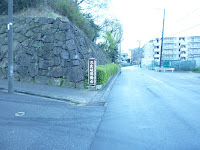 Udon Hand-made Noodle Cooking
Udon Hand-made Noodle CookingUdon noodles are to the Japanese what hamburgers are to the fast food nation. A quick and easy meal can be made with the thick, rich noodles mixed in a thin broth of fish stock and some vegetables. In this case, the noodles were the perfect addition to the tempura-fried wild plants that we had picked while hiking.(see April 25th 2010)
Roots that lie on the Chinese Continent
 The noodle - the origin of both udon and somen - is believed to have been imported to Japan from China in the 8th century. Tracing its origins brought us to the middle reaches of the Yellow River in a time before the birth of Christ. The noodle culture that developed here was transmitted to Japan as part of the varied continental culture of China. Thereafter, this food was influenced by local culture and was further developed with the addition of soy sauce and sweet sake.
The noodle - the origin of both udon and somen - is believed to have been imported to Japan from China in the 8th century. Tracing its origins brought us to the middle reaches of the Yellow River in a time before the birth of Christ. The noodle culture that developed here was transmitted to Japan as part of the varied continental culture of China. Thereafter, this food was influenced by local culture and was further developed with the addition of soy sauce and sweet sake.
 The noodle - the origin of both udon and somen - is believed to have been imported to Japan from China in the 8th century. Tracing its origins brought us to the middle reaches of the Yellow River in a time before the birth of Christ. The noodle culture that developed here was transmitted to Japan as part of the varied continental culture of China. Thereafter, this food was influenced by local culture and was further developed with the addition of soy sauce and sweet sake.
The noodle - the origin of both udon and somen - is believed to have been imported to Japan from China in the 8th century. Tracing its origins brought us to the middle reaches of the Yellow River in a time before the birth of Christ. The noodle culture that developed here was transmitted to Japan as part of the varied continental culture of China. Thereafter, this food was influenced by local culture and was further developed with the addition of soy sauce and sweet sake. The oldest historical reference to Sanuki udon is a drawing on a 300-year-old folding screen. Konpira Sairei-zu, ("Festival drawings from the shrine of Konpira, the guardian deity of seafarers") a possession of the oldest shrine Konpiragu, is mounted on a folding screen and depicts in detail the temple town of that time. Three udon-ya restaurants are clearly depicted. At that time, udon-ya restaurants existed in large cities such as Tokyo and Osaka. That the temple town of Konpiragu had udon-ya restaurants during this period reveals that Sanuki enjoyed a developed udon culture from an early period.
Making hand-made noodles is fairly easy but requires some time in allowing the noodles to rest, some elbow-grease when kneading and softening the dough, and some skills when cutting the nooodles.We used a strong wheat flour mixed with salted water.
Teuchi-Udon (Handmade noodles)
Ingredients:(2-3 servings)
250g, Medium -strength flour ( or ready-made noodles flour, or mixture of flour for bread and all purpose flour (1:1))Approx. 120cc water, 1Tbsp or less salt (for salt water), flour for bread, or katakuri-ko( potato-starch)
Directions:
Make salt water : Dissolve 1Tbsp. salt in water.
Mixing flour with salt water : Add salt water to flour little by little , mix and knead it to become like rough powder using both hands.
Ingredients:(2-3 servings)
250g, Medium -strength flour ( or ready-made noodles flour, or mixture of flour for bread and all purpose flour (1:1))Approx. 120cc water, 1Tbsp or less salt (for salt water), flour for bread, or katakuri-ko( potato-starch)
Directions:
Make salt water : Dissolve 1Tbsp. salt in water.
Mixing flour with salt water : Add salt water to flour little by little , mix and knead it to become like rough powder using both hands.

The first leaving time : Place the dough into the plastic bag, leave it for 30min.
The second mixing and leaving time :Take it out from the plastic bag. Knead and make it into the circle shape by rubbing.This was best done by taking your shoes off and kneading with your bare feet!
 Everyone got a 'kick' out of this because they had never done it before.
Everyone got a 'kick' out of this because they had never done it before.  You don't have to be "light on your feet" nor the greatest dancer to enjoy kneading the dough by tip^toeing gently across the dough.
You don't have to be "light on your feet" nor the greatest dancer to enjoy kneading the dough by tip^toeing gently across the dough. 
 The purpose is to remove the air pockets from the first Nekase(resting) and to soften the noodles to a more elastic state.(Nekase #2) Leaving the dough to rise for an 1 hour again.
The purpose is to remove the air pockets from the first Nekase(resting) and to soften the noodles to a more elastic state.(Nekase #2) Leaving the dough to rise for an 1 hour again. (Nobase) Rolling out the dough: Sprinkle some flour on the board, roll out the dough until it is evenly thinned out to about 3mm thickness.


Cutting with knife :Sprinkle lots of flour on it, fold it like a folding screen. Cut from the edge in the 3mm thickness.
Boiling noodles : Boil a generous amount of water in the large pot ( 3-4L water for 250g noodles), pat off extra flour of noodles and cook them for 8-10min.with stirring up slowly.
 NOTES : For Kamaage-Udon : It's better that the boiling time is shorter than usual.
NOTES : For Kamaage-Udon : It's better that the boiling time is shorter than usual. After boiling the noodles to the desired texture(usually 4-5 minutes in boiling salted water) Rinse off the excess flour by washing the noodles in water.
We served the noodles in two manners: one way was Zaru, which is just noodles served cold with grated ginger, a lime slice and soy sauce. the other way involved serving the udon noodles with seasoned fish stock and the tempura-fried wild edible plants that we hade picked on the hike.
Tempura Batter Makes 4 servings
Ingredients:
· 1 large egg
· 1 cup ice water
· 1 cup all purpose flour
Preparation:
Beat an egg in a bowl. Add ice water in the bowl. Be sure to use very cold water.
Tempura Batter Makes 4 servings
Ingredients:
· 1 large egg
· 1 cup ice water

· 1 cup all purpose flour
Preparation:
Beat an egg in a bowl. Add ice water in the bowl. Be sure to use very cold water.
Add sifted flour in the bowl and mix lightly. Be careful not to over mix the batter. Clumps are better.
Wash and rinse all sansai you wish to fry. When the frying oil is at the desired temperature
(test by dropping a few drops of batter in. If the batter sinks the temperature is about 160. If the batter should come up to the surface and float, it’s at 180)
Lightly flour the sansai and add quickly to the oil. Be careful of splashing.
When the tempura floats and becomes solid the tempura should be removed and placed on parchment paper to remove excess oil.

Wash and rinse all sansai you wish to fry. When the frying oil is at the desired temperature
(test by dropping a few drops of batter in. If the batter sinks the temperature is about 160. If the batter should come up to the surface and float, it’s at 180)
Lightly flour the sansai and add quickly to the oil. Be careful of splashing.
When the tempura floats and becomes solid the tempura should be removed and placed on parchment paper to remove excess oil.



 Thank you all for coming. I hope you had a nice outing on the hiking course and gained some knowledge about traditional Sansai cooking in Japan
Thank you all for coming. I hope you had a nice outing on the hiking course and gained some knowledge about traditional Sansai cooking in Japan











 and the start of the hiking trail
and the start of the hiking trail



















 from the South entrance of the park it's only a twenty minute walk back to Kamiooka station if you take a short-cut over the hill and past Maito Elementary school.
from the South entrance of the park it's only a twenty minute walk back to Kamiooka station if you take a short-cut over the hill and past Maito Elementary school. There was an interesting cemetery at the top of the hill. Because it had a view of the surrounding mountain side the plots themselves are very expensive. Your eternal resting place needs a view, I guess.
There was an interesting cemetery at the top of the hill. Because it had a view of the surrounding mountain side the plots themselves are very expensive. Your eternal resting place needs a view, I guess. Going over the mountain if you get lost, just look for the large KEIKYU dept building sign and it will lead you back to the station.
Going over the mountain if you get lost, just look for the large KEIKYU dept building sign and it will lead you back to the station.